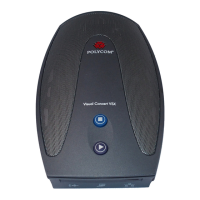5. Status Messages
The Vortex sends status messages via RS-232 and EF Bus any time one of its internal parameters changes. This
means that the host program does not need to continually poll the Vortex in order to detect status changes.
Status messages are in the same format as the commands used to set the corresponding parameter.
For example, suppose you send the command 'F**GAINIA10' and there are two EF2280's linked together with
device IDs 3 and 7. The EF2280's will respond with 'F03GAINIA10' and 'F07GAINIA10', respectively. Now,
someone uses the front panel of the EF2280 set to ID 7 to decrease input A's gain by 1 dB. When this happens,
the EF2280 will respond with 'F07GAINIA9'. This example illustrates that status messages can be sent as the
result of an RS-232 command or as the result of some other change in the Vortex device such as front panel
adjustments, logic inputs, etc.
Status messages can be turned off via the
ACKMOD command. ACKMOD refers to acknowledgement mode since
the term status message and acknowledgement are synonymous for our purposes.
6. Command Types
Many of the Vortex commands have similar formats. The main formats are described here in order to provide a
better understanding of the command set.
6.1. Boolean Commands
Boolean commands take one of the three following arguments.
● '0' indicates that the parameter should be turned off.
● '1' indicates that the parameter should be turned on.
● '2' indicates that the parameter should be toggled (i.e., '0' becomes '1' and '1' becomes '0').
Parameters associated with boolean commands can be queried using the '?' character. For example, if input A is
muted, and you send 'F04MUTEIA? ', the EF2280 will respond with a status message of 'F04MUTEIA1 '. When a
status message is generated for a boolean command, the command data will either be a '0' or '1', since '2' is
obviously not a valid state.
6.2. Integer Commands
Integer commands can take one of two types of arguments. The first argument type is absolute, meaning that
the parameter will be set to the specified number. For example, 'F04GAINIA10 ' means that the gain on input A
will be set to 10 dB. In this case, the device will respond with a status message of 'F04GAINIA10 '.
The second argument type is relative, meaning that the parameter will be incremented or decremented by the
specified amount. The increment character is '>' and the decrement character is '<'. For example, 'F04GAINIA>3
' increments the gain on input A by 3 dB. If the input's gain was previously set to 6 dB, then it would now be set
to 9 dB. In this case the device would respond with a status message of 'F04GAINIA9 '.
The numeric part of both the absolute and relative arguments can contain a '+' or '-' to indicate the algebraic
sign of the argument. If no sign is given, '+' is assumed.
The parameters associated with integer commands have maximum and minimum values associated with them. If
you try to set a parameter above its maximum or below its minimum, the parameter will be set to its maximum

